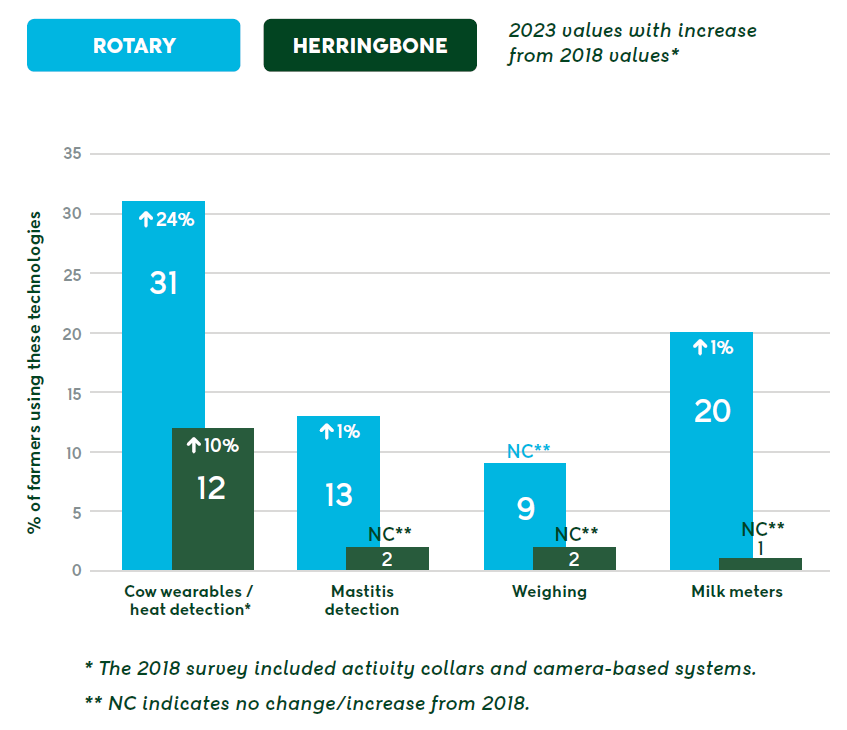As herd sizes increase, labour pressures persist and more farming technologies emerge, New Zealand dairy farmers have been investing more on herd and milking management technology. DairyNZ has been tracking this trend since 2008, using five-yearly surveys to collect objective data about dairy farmers’ milking practices and technology use, as well as information on some farm-wide technologies and facilities. The latest survey completed in May 2023 shows automation investments remain a focus for farmers, but wearables are on the rise.
What this research means for you
The survey findings help you by sharing what practices are trending, the efficiencies they provide, and support other farmers to increase productivity and efficiency on-farm.
The full report contains data and analysis on automation technology in the dairy, animal monitoring technology, what's next, measuring milking efficiency, and pasture monitoring technology.
The mission
This research project tracks NZ dairy farmers' workplace practices and technology trends using five-yearly surveys to collect data. The 2023 survey included approximately 500 farmers with herds larger than 100 cows with a 50:50 split of farms with rotary and herringbone dairies.
This data helps to understand dairy farmers’ milking practices, and how they’re using technology to help with milking and animal management.
The 2023 survey also explored technology and infrastructure for grazing management, stand-off facilities, and heat stress management.
The results
The 2023 survey results show that New Zealand dairy farmers are investing in more technology to help with automation in the dairy shed and herd management.
Automation technologies in the dairy shed
Farmers are using automation technology to be more efficient in the dairy, meaning fewer people are required for milking.
Most new rotary dairies have three labour-saving technologies – ACRs, automatic teat spraying and automated drafting – to reduce the number of people needed for milking. This eliminates the need for a person working at cups-off, boosting milking efficiency.
In herringbone dairies, fewer technologies are being adopted. However, a herringbone dairy can be highly labour efficient (cows milked per person/hour) when there is one person milking, there is a limit to the number of sets of cups one person can manage – typically up to 30 sets.
Animal monitoring technology
Cow wearables, which include sensors worn on collars, ear tags, leg tags or rumen bolus, have seen a large increase in uptake since 2018, led by large farms with rotary dairies. The technology has a range of uses, including monitoring heat and other health markers, tracking the location of cows, virtual herding and fencing.
Cow wearables are easy to implement because they’re not reliant on other infrastructure. In some cases, they can integrate with other technologies – like automatic drafting.
Which animal monitoring technologies are farmers using?

Pasture monitoring technology
Assessment of pasture availability is an important piece of information for NZ dairy farmers. Visual estimation was the primary assessment method during spring by over half the farmers surveyed. The next most popular method was use of a rising plate meter (RPM), used by 22% of farmers. There was greater use of satellite-based data than in the 2018, but it is only the primary assessment method for 5% of NZ farmers.
Around 45% of farmers were recording their pasture assessment data in some form of software or spreadsheet, 16% kept paper-based records, and 30% did not formally record the collected pasture data.
Method of measuring pasture cover

Dr Callum Eastwood
A social scientist, Callum leads projects in workplace design, workplace productivity, reducing dairy sprains and strains, and technology adoption. He specialises in technology adoption and integration using innovative and practical solutions on farm. Callum works closely with farmers and enjoys using co-design approaches to bring different perspectives to solving farming challenges, this includes having farmers and other stakeholders in the room together. For Callum, it's not just about creating science solutions, but ensuring they work for farmers.
Brian Dela Rue
A research engineer, Brian enjoys working alongside farmers and technology developers to better understand farmer needs and opportunities to improve workforce productivity and workplace design. Providing information to support farmers in making investment decisions in technologies that will add value to their farm business and work well for their farm teams is a key part of his role.
Research team